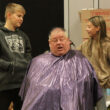Sean C. Morgan
Sweet Home city staff are preparing a draft ordinance that will require property owners to tear down vacant blighted homes, if it is approved by the City Council.
The council’s Public Safety Committee passed a recommendation to that effect during a meeting on Aug. 28.
Staff developed a draft ordinance in response to a petition by neighbors of 1133 Redwood St., which is vacant and has fire damage.
They requested that the council pass legislation that would take care of the abandoned and blighted structures in the community, said City Manager Craig Martin. Right now, the city can do nothing unless a structure poses a threat to health and safety, such as when a structure is likely to collapse and damage neighboring property.
Property owners can keep unattractive houses that are boarded up, Martin said.
City staff researched what other cities do across the nation, said Community Development Director Carol Lewis. Most of them were in Virginia and California, and the staff also looked at Oregon cities. Lincoln City has some of the most stringent requirements on second homes.
Some cities are “very strict,” she said.
Staff members completed a draft of rules that would fall under the nuisance ordinance for the council’s consideration, she said. The draft ordinance requires a level of maintenance that protects livability and appearance.
The rules refer to state law and urban renewal programs to define blighted property, Lewis said.
Before the city may take action under the proposed ordinance, a structure must be both vacant and blighted, as defined in the ordinance.
Blighted properties contain structures that are not secured, into which the public can gain entry without the consent of the owner. They also may include partially constructed, reconstructed or demolished buildings where work has been abandoned and has no current building or demolition permit.
The building also may be in a state of disrepair, with exterior walls or roof coverings that do not provide adequate weather protection, which may result in infestations or dry rot. The structure may have broken or missing windows, and the exteriors may be visibly broken, deteriorated or substantially defaced.
Blighted properties also include buildings and structures that are intended for living, commercial, industrial or other purposes but are unfit or unsafe to occupy because of a defective design or poor quality of construction, obsolesence, deterioration or dilapidation.
Temporary protection, such as tarps, black plastic or similar materials, may be used on such structures for a maximum of 90 days except when a longer period is needed to process an insurance claim or the code enforcement officer grants a one-time extension of 30 days.
All boards used to secure windows, doors or other parts of a building must be painted the same primary color as the structure.
“There are some that people live in that is very similar to this situation,” said Councilor Scott McKee Jr.
As the ordinance was presented, it may have allowed the city to respond to occupied residences. Staff and councilors say there could be around 100 homes that have blue tarps over their roofs. Lewis estimated there are 30 to 50 vacant and blighted buildings in the city.
“If we have the code, we’ll have to start looking,” Lewis said. “When we see one, we have a responsibility to process that like anything else.”
It cannot be complaint-driven either, Martin said. When the code enforcement officer responds to one, he cannot drive by and ignore the other three he passes while traveling there. When those property owners call, that can generate a couple of more complaints.
Staff provided photos of some 28 properties that could be affected by the staff’s proposed ordinance, all of them vacant but not necessarily blighted by definition. Among them is 2210 Tamarack St., the partially demolished mill buildings now owned by Linn County, which foreclosed the property for nonpayment of property taxes; the railroad depot behind McDonald’s; and the old Chevron fuel station at the corner of 18th and Main.
They are structures that fall short of the dangerous buildings code, Martin said.
“I don’t think the intent is to clean up the whole city and have Beverly Hills,” said Councilor Ron Rodgers, adding that the process started due to council concerns about buildings that had been abandoned for years.
Sweet Home is a poorer community, and it has a lot of roofs that might cost upward of $6,000 to repair, he said. Property owners may not be able to afford that, so they cover as best they can with tarps.
“Are we creating a hardship for people?” he asked. “Especially retirees.”
The retiree on a limited income might be able to pay the taxes on the home but have difficulty paying for repairs, Rodgers said.
There is a housing rehab program, with no-interest loans, that can help low-income homeowners, Martin said. The loan doesn’t need to be repaid until the property is sold. “There are some tools out there to address Councilor Rodgers’ concerns about folks in that situation.”
“I do hear people complaining about occupied premises and why does the city allow them to have a blue tarp,” Lewis said. Those people are probably making an economic choice where replacing the blue tarp once a year costs $20 instead of $5,000 for a new roof, she said.
Rodgers said the city should ignore the blue tarps for now and see what it can get done going after structures that are both vacant and blighted.
“There was no intention to force people from their homes, and that’s what we’re going to start doing with what’s in here,” Rodgers said.
Committee members McKee and Greg Mahler agreed, but the committee agreed that any boards on occupied homes should be painted to match the structure.
With the adjusted requirements for city involvement, requiring structures to be both vacant and blighted, the Public Safety Committee approved the proposed ordinance, which will be revised and then submitted to the full City Council for public hearings and a decision.
Present at the Public Safety Committee meeting were its three members, councilors McKee, Mahler and Rodgers.
The regular City Council meeting preceded the Public Safety Committee. The council voted 7-0 to consider a request to vacate a portion of Dogwood Street in the 1600 block. It would affect two properties on 16th and 17th avenues.
The request followed a property owner’s request for a fence permit that would have intruded into the city’s right-of-way on the south side of the street. Other properties have fences and yards in the right-of-way, with an average intrusion of 10 feet.
The request will return to the council later for a public hearing.
Present at the meeting were councilors Marybeth Angulo, Mahler, Jim Gourley, Mayor Craig Fentiman, McKee, Rodgers and Mike Hall.




